Gentlemen.
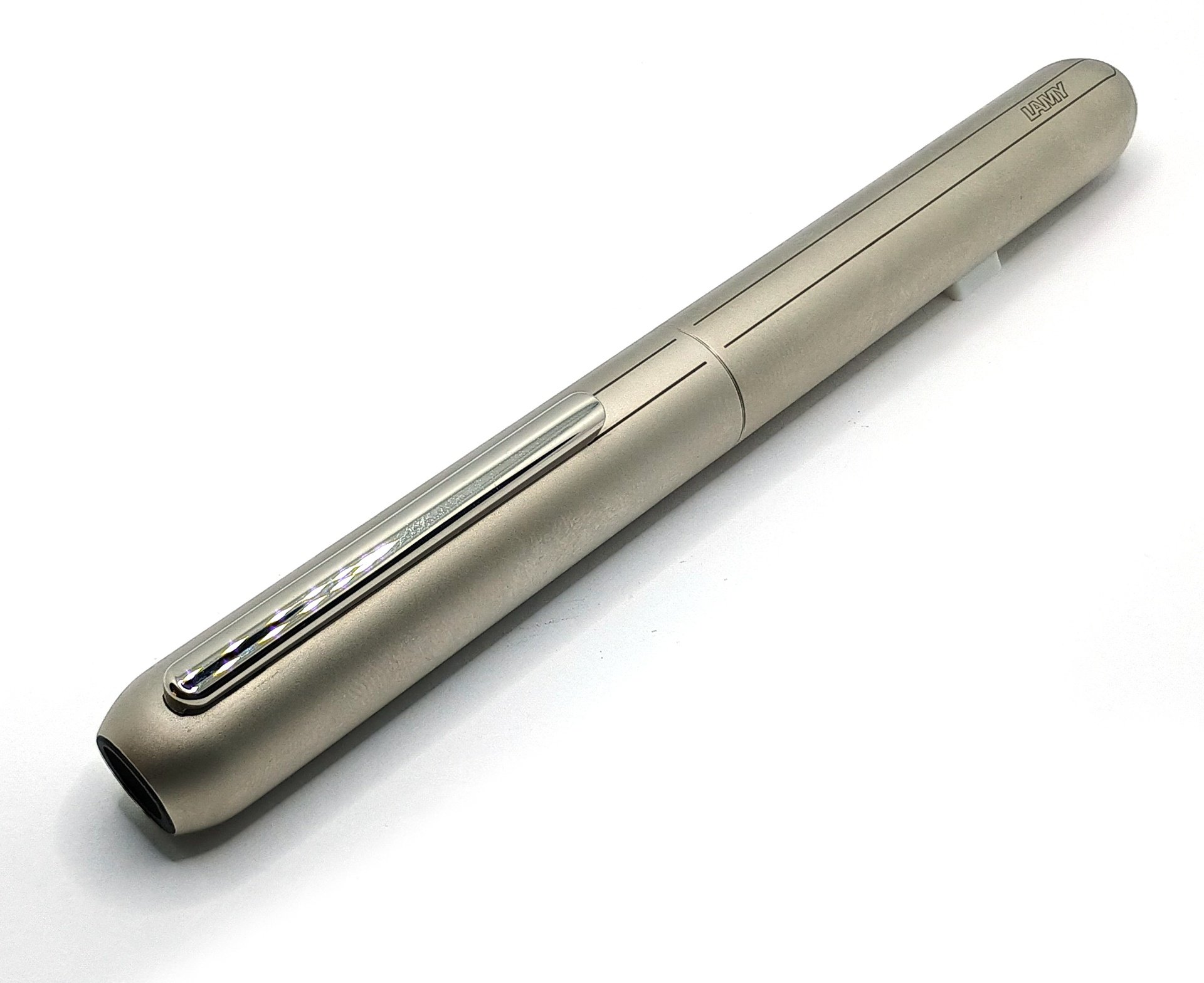
I promise I’m not doing this as a showing-up. Given my predilection for retractable fountain pens, I’ve had my eye on one of these for years and it’s the one I’ve never actually been able to own. Up until now, anyway, because I finally found the opportunity to get my hands on one without going broke. This legitimately did just show up the mail just recently.
And since we don’t get to do this every day, why not share in the unboxing experience of a pen that lists for four hundred United States dollars?
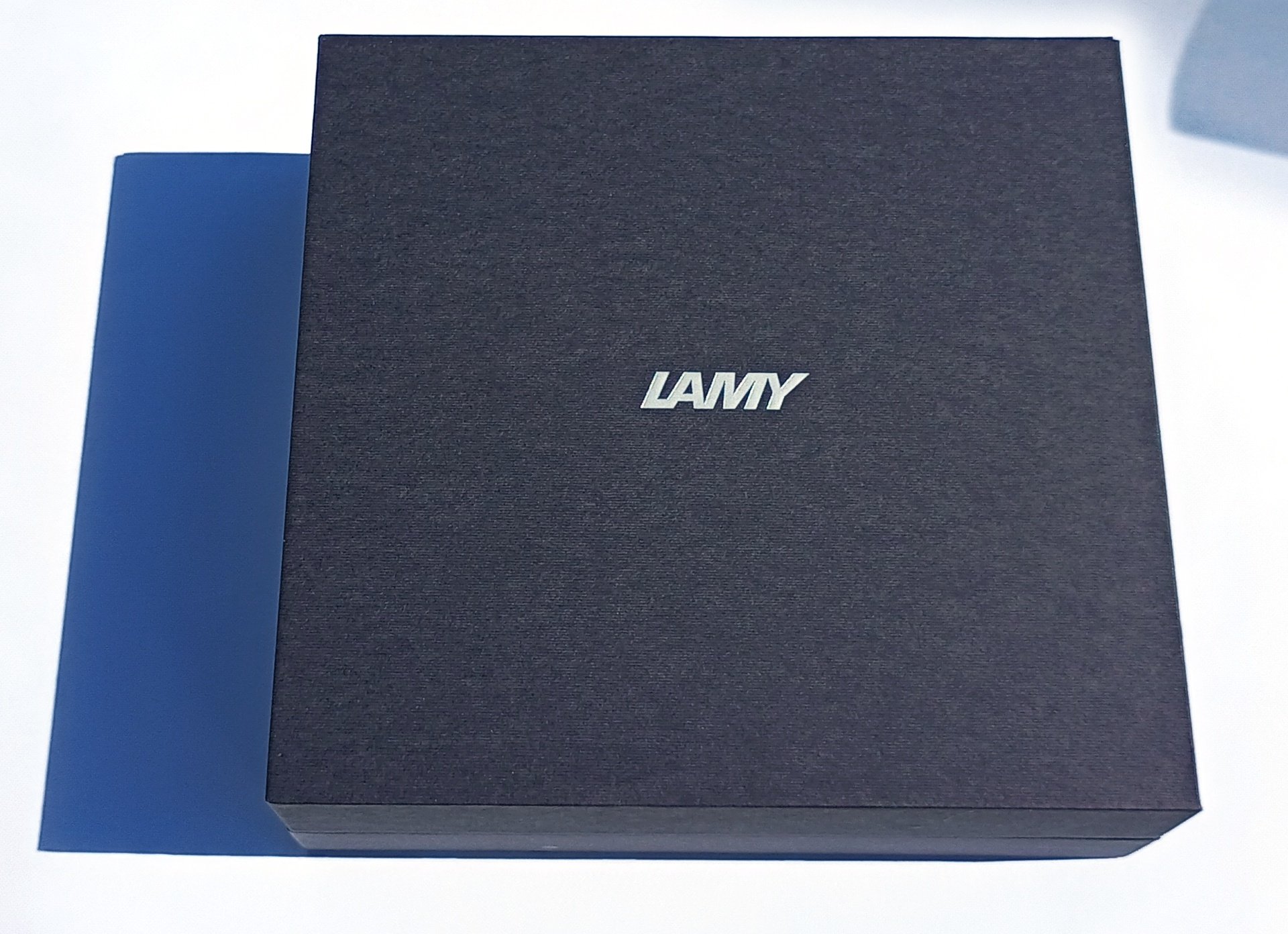
It seems how seriously the manufacturer takes any given pen is directly proportional to the size of the box it shows up in. The box my Oaso K012 came in, for instance, could barely contain a deck of cards. Hell, my Ohto F-Lapa didn’t even come in a box at all, just a flimsy baggie.
The Dialog, meanwhile, comes in a woven-textured matte presentation box that’s so big it won’t even fit in my illuminated photo booth, so to get this picture I had to take it outside. Hence the shadow. It’s 7-1/8" square and if my algebra is correct, if you were so inclined you could easily fill it with about 44 Lamy Dialogs.
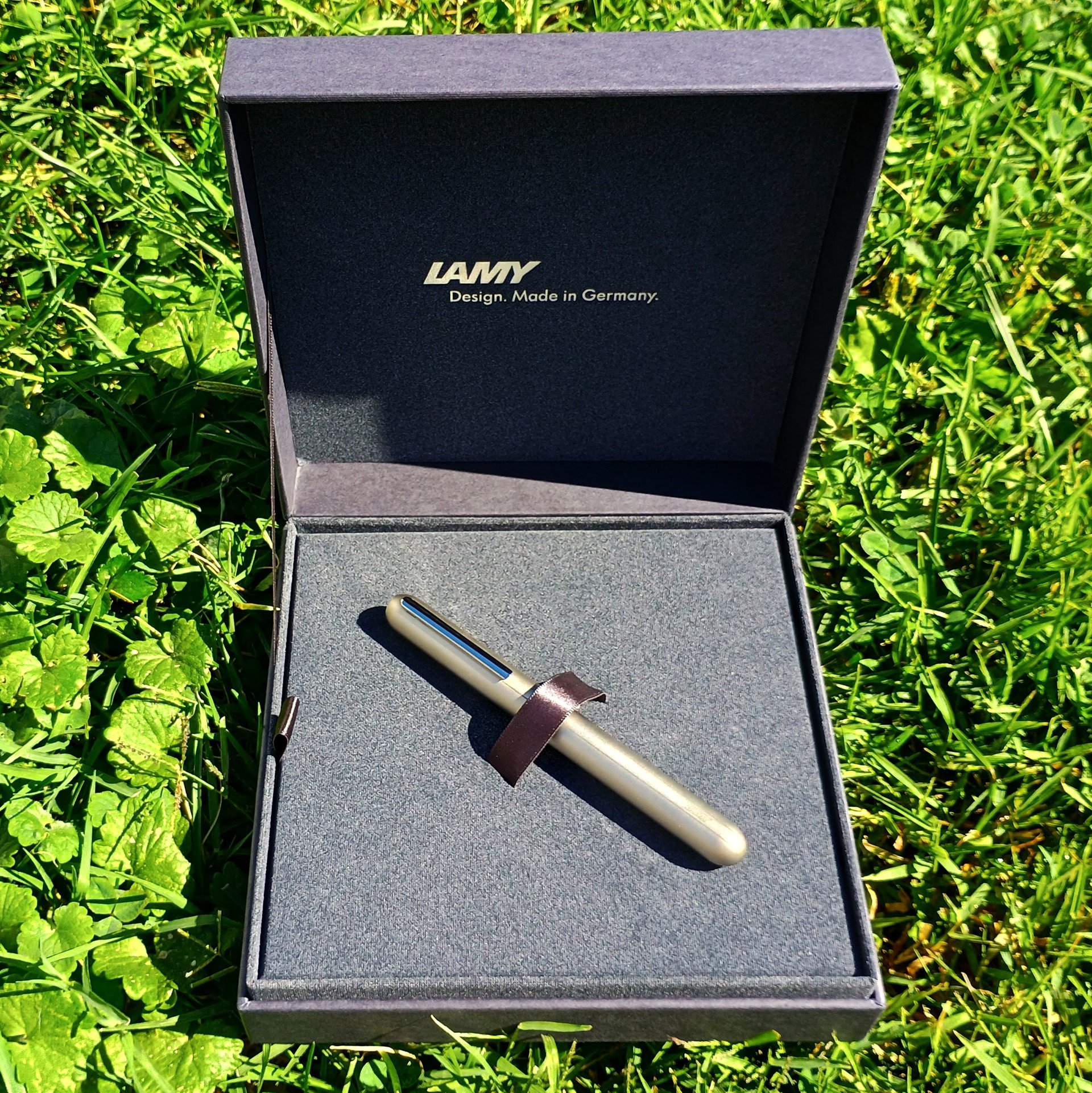
But alas, inside you only get one.
The box is lined with some kind of fuzzy fabric all over the inner surfaces, and the walls of the lower half of it, at least, feel like they’re about five layers thick.

The Dialog is one of Lamy’s flagship pens. Thus as you would expect, the Germans left very few stops unpulled when they were constructing it. The body is all aluminum, with various internal structures made of stainless steel. It’s ridiculously dense, weighing 46 grams precisely with a standard Lamy ink cartridge installed. It is without a doubt the heaviest fountain pen I own and possibly the heaviest I’ve ever handled for any length of time. For comparison, my OG Pilot Vanishing point – which is made of brass, mind you – also feels incredibly dense but still only weighs 29.8 grams.

Lamy always go for a Euro-chic minimalist vibe with their nicer pens and the Dialog is certainly no exception. Its profile is a postmodern, completely untapered capsule shape with nearly spherical ends. It is thus exactly 14mm in diameter down its entire length by my measure, or 0.551", not including the clip. So that’s actually slightly thicker than a Platinum Curidas and noticeably thicker than a Vanishing Point or clone thereof. If you are a fancier of slim pens, this one probably isn’t for you.
It’s available in four finishes: The satin silver I got, matte black, and a duo of “piano” gloss black or gloss white that frankly I’d be terrified to even store outside of the box. The latter two have got to be both fingerprint and scratch magnets. That, and they almost look like they’re trying to be an Apple product.
So yeah, I got the silver one.
And this is the current Dialog 3, not the slightly newer Dialog CC which is shorter, has an aesthetically different tail, and lacks the pocket clip. What kind of heathen philistine would want a pen like that with no clip is beyond me, but the option to pander to such strange individuals does at least exist.
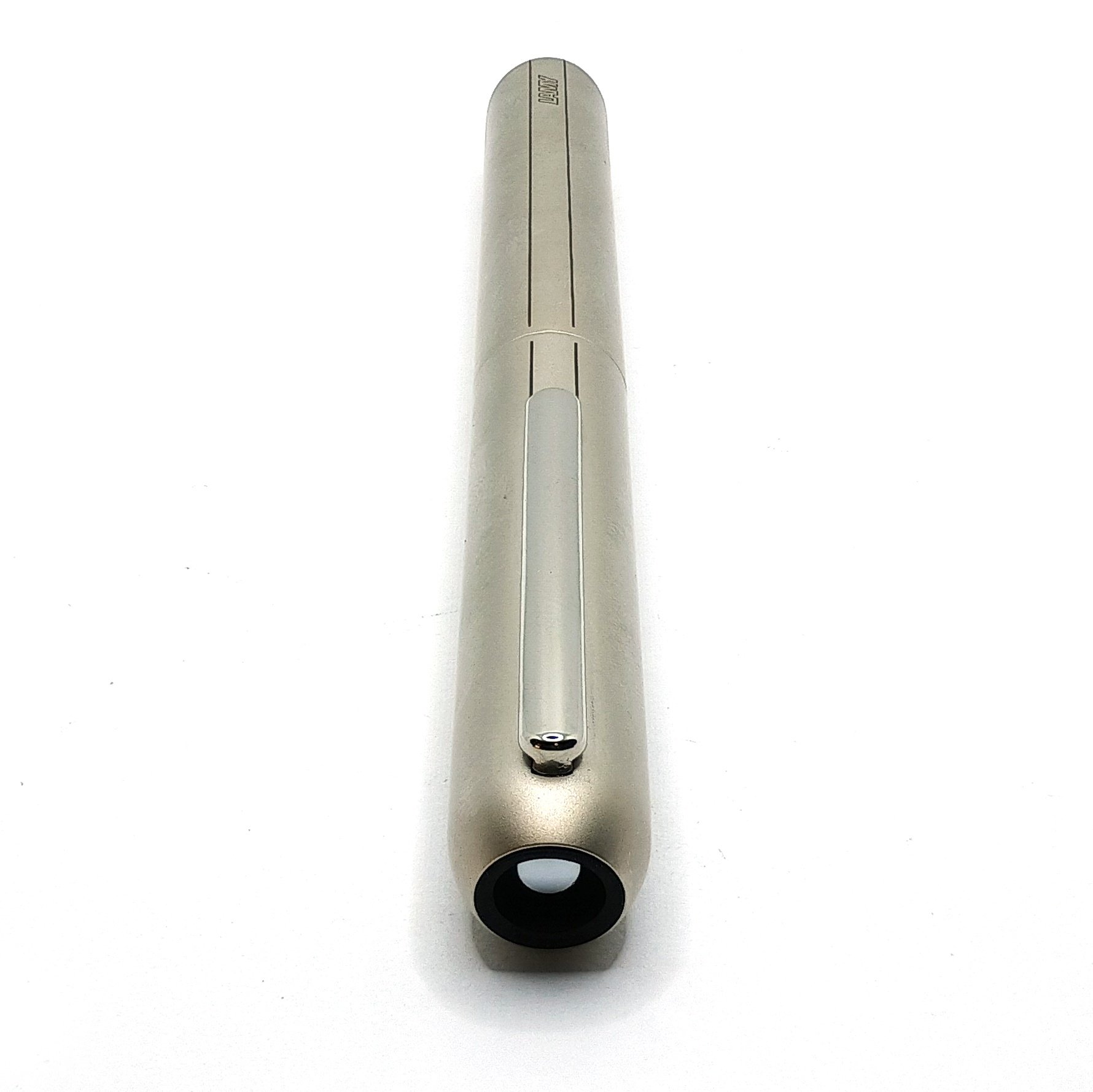
The Dialog is, needless to say, a retractable fountain pen. One of the very few entries into that select brotherhood, in fact, along with the Pilot Vanishing Point and its clones, the Platinum Curidas, the aforementioned Oaso K012, and the historical and quite collectible Platinum Knock and OG Pilot Capless. There may be others. Those are the ones I can think of off the top of my head.
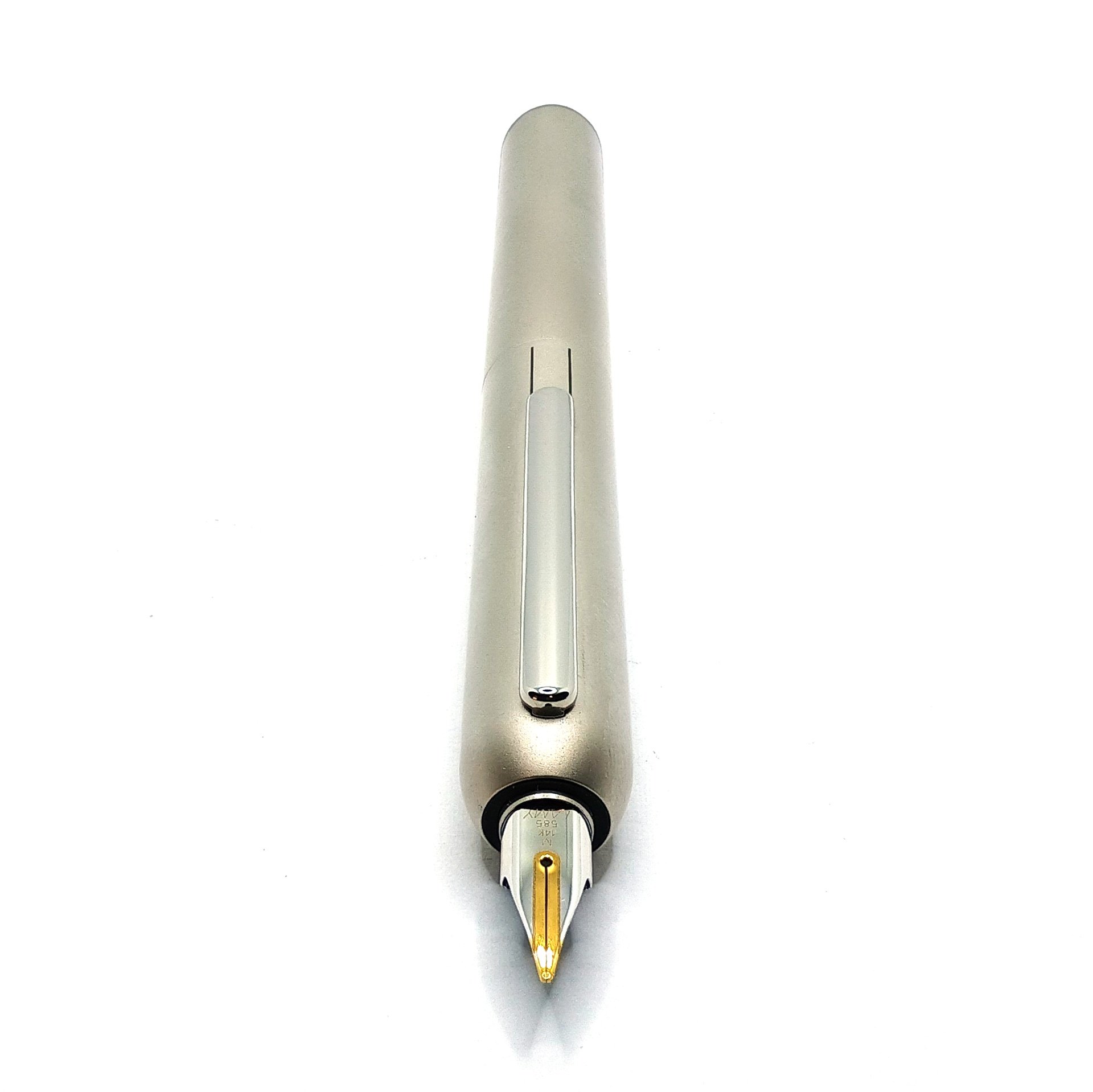
As the youngsters are fond of saying these days, no cap.
The Dialog is unique among all of these because it’s the only one that’s not a click pen – It is a twist-to-extend mechanism, instead.
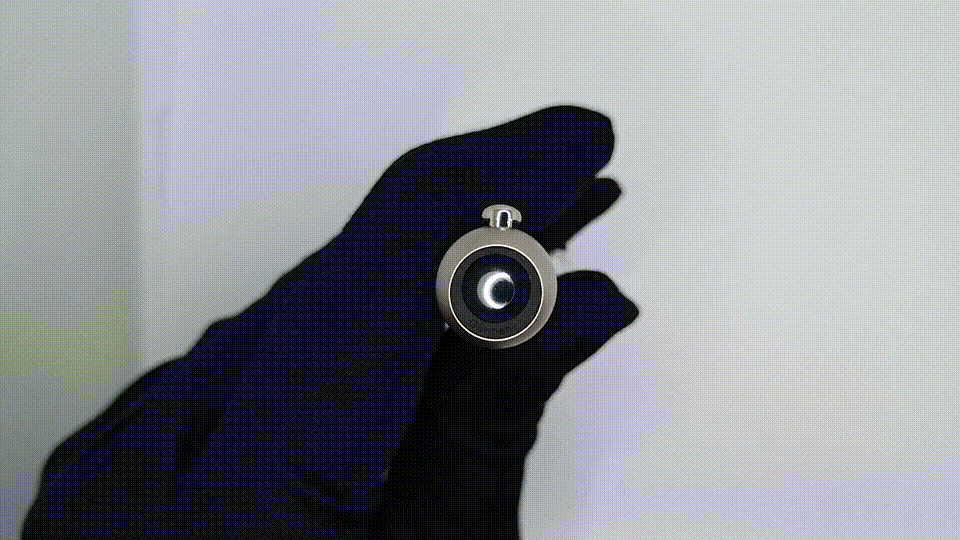
Here’s the part you all want to see.
The various retractable fountain pens of the world use an array of mechanisms to prevent themselves from drying out when their points are retracted. Hinged or spring loaded trap doors, or in the case of Oaso’s entry a flexible rubber diaphragm. The Dialog meanwhile uses what Lamy describes as a “ball valve,” a hemispherical rotary cover that pivots into place over the open end of the pen when you retract the point.
The Dialog’s operation is a mechanical symphony conducted by a helical thread inside the grip section that drives three separate mechanical actions. First is the extension and retraction of the point itself, second is the operation of the ball valve cover…
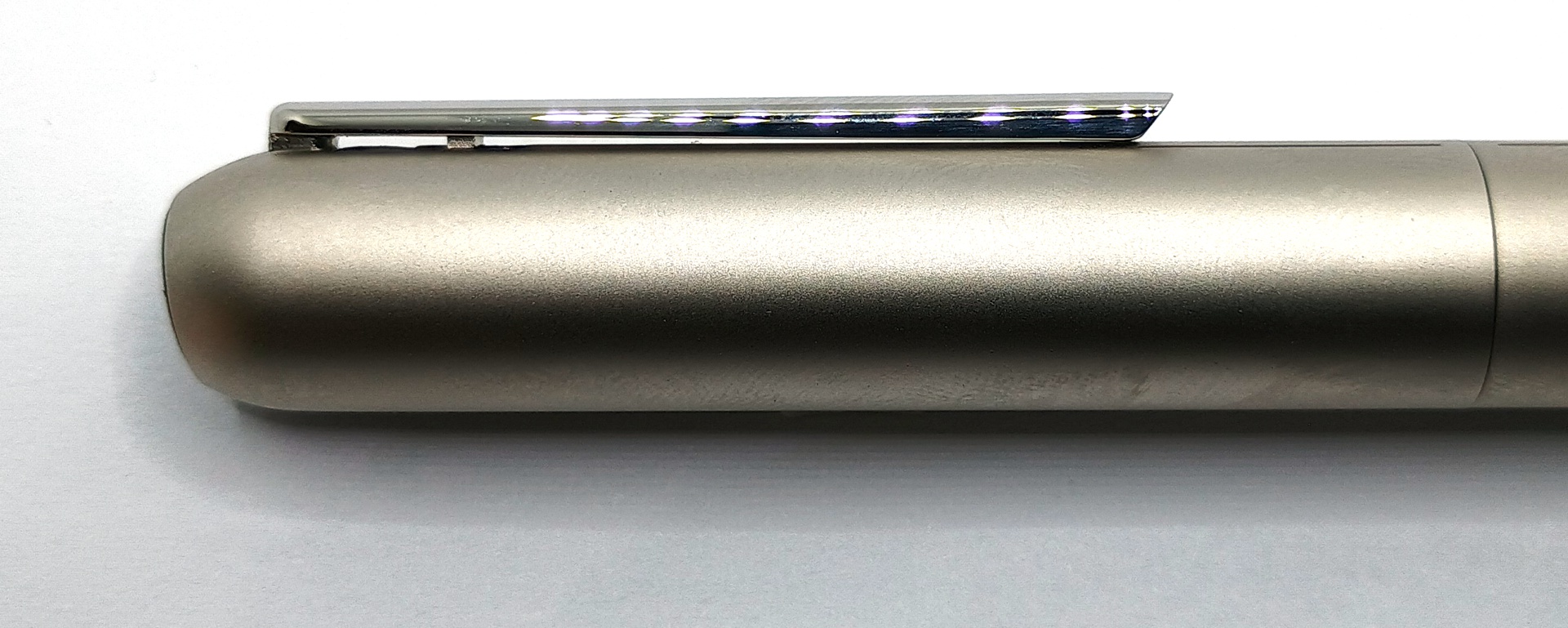
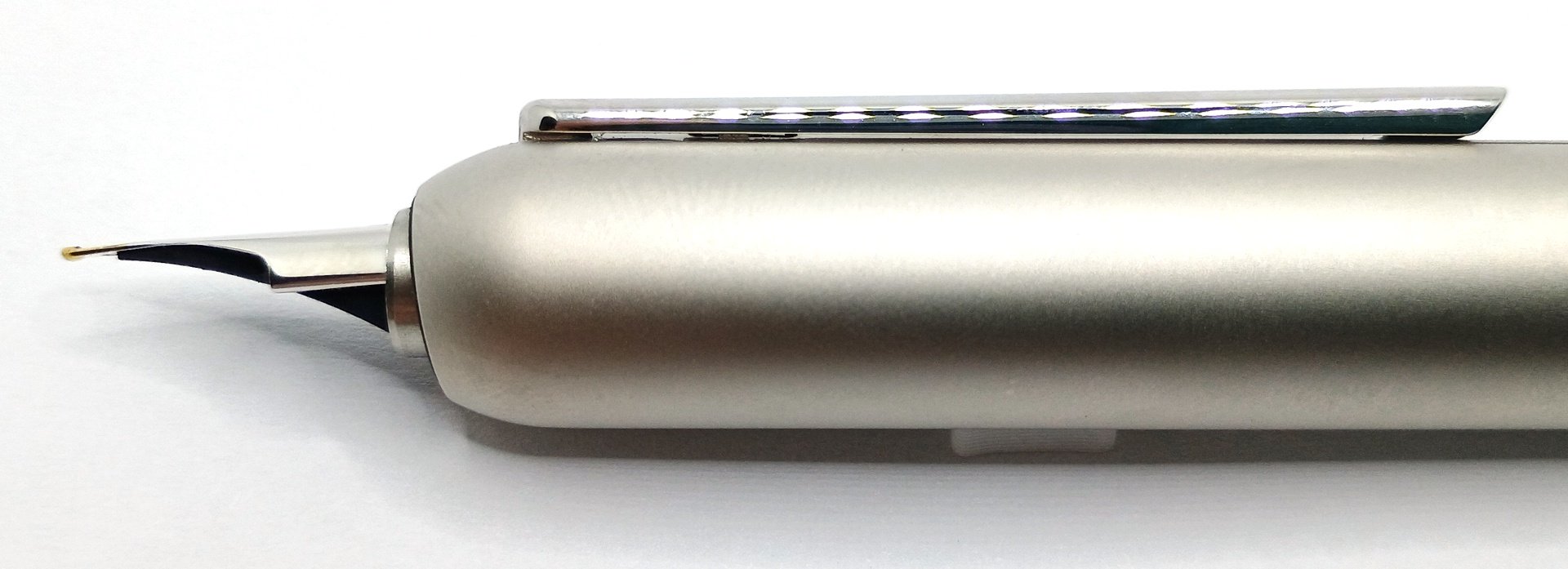
…And third is the slight but noticeable retraction of the clip when the point is extended. Now, Lamy’s marketing materials try pretty hard to imply that the clip sinks flush into the pen body but this is not the case. It would be rad it if it did. But the retraction is only probably about two millimeters. Note the difference in the amount of daylight showing through the gap in the pictures above.
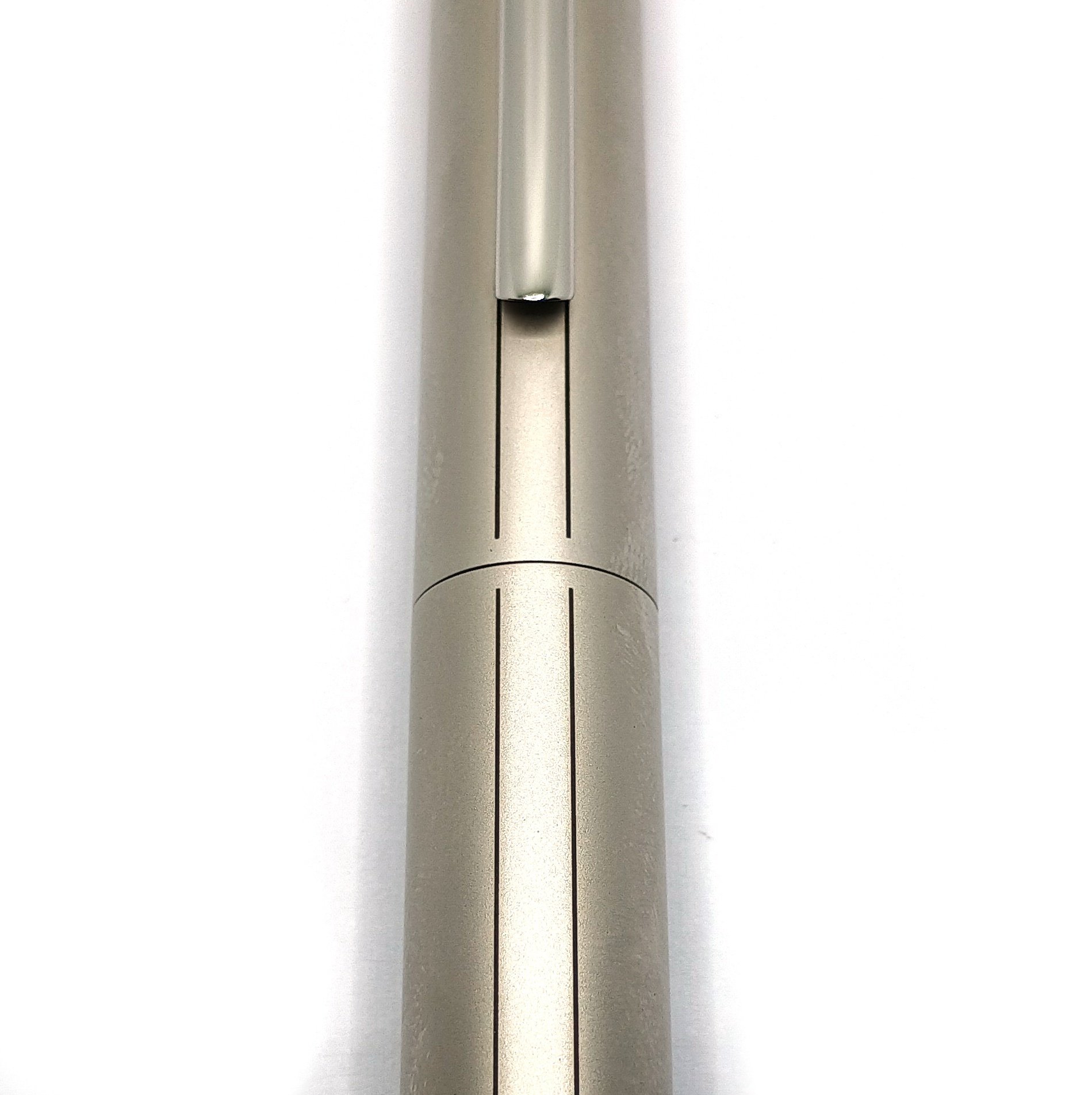
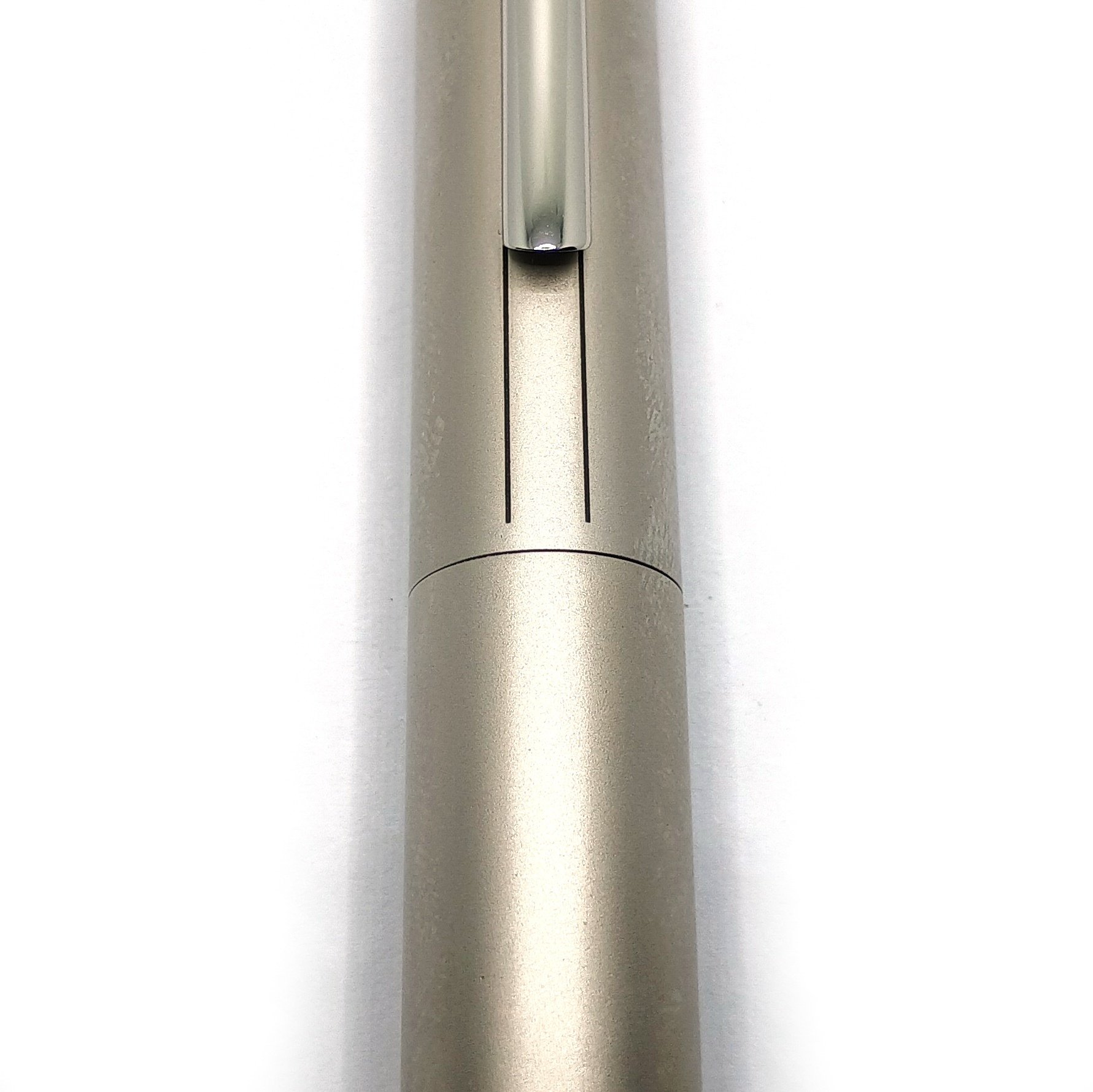
The Dialog’s twist mechanism has a tactile detent in it when you rotate it into either the fully extended or retracted positions. There is no tactile indicator on the surface of the pen body, though; it’s completely smooth all the way around. Instead there is a visual indicator in the form of these two pairs of lines marked on both halves of the body. When the point is fully retracted these all line up with each other as shown.

The Dialog comes packing Lamy’s fanciest premium nib, their “Z 55” which is made of 14k gold with platinum plating. I got the medium variant, the 585. The gold nib is fairly flexible although at least with the medium point the variation in stroke width with pressure and direction is fairly subtle. (Magnified shot here, although it fell out of my depth of field slightly.)
I prefer a broad-ish stroke and the 585 certainly delivers on that front. It’s the second fattest you can get in Lamy’s gold nibs, and the second fattest overall without going to one of their calligraphy or oblique options. Lamy’s entire line of nib widths – which they inexplicably call “grades” as if to imply that one is better than another which is obviously nonsense – trend wider than their Asian counterparts. A Lamy fine is probably more akin to a medium from many of the Japanese makers, for instance.
So this nib combined with the Dialog’s feed is a very wet writer as evidenced by the feathering on the cheap Post-It I used for my headline photo as well as this comparison:
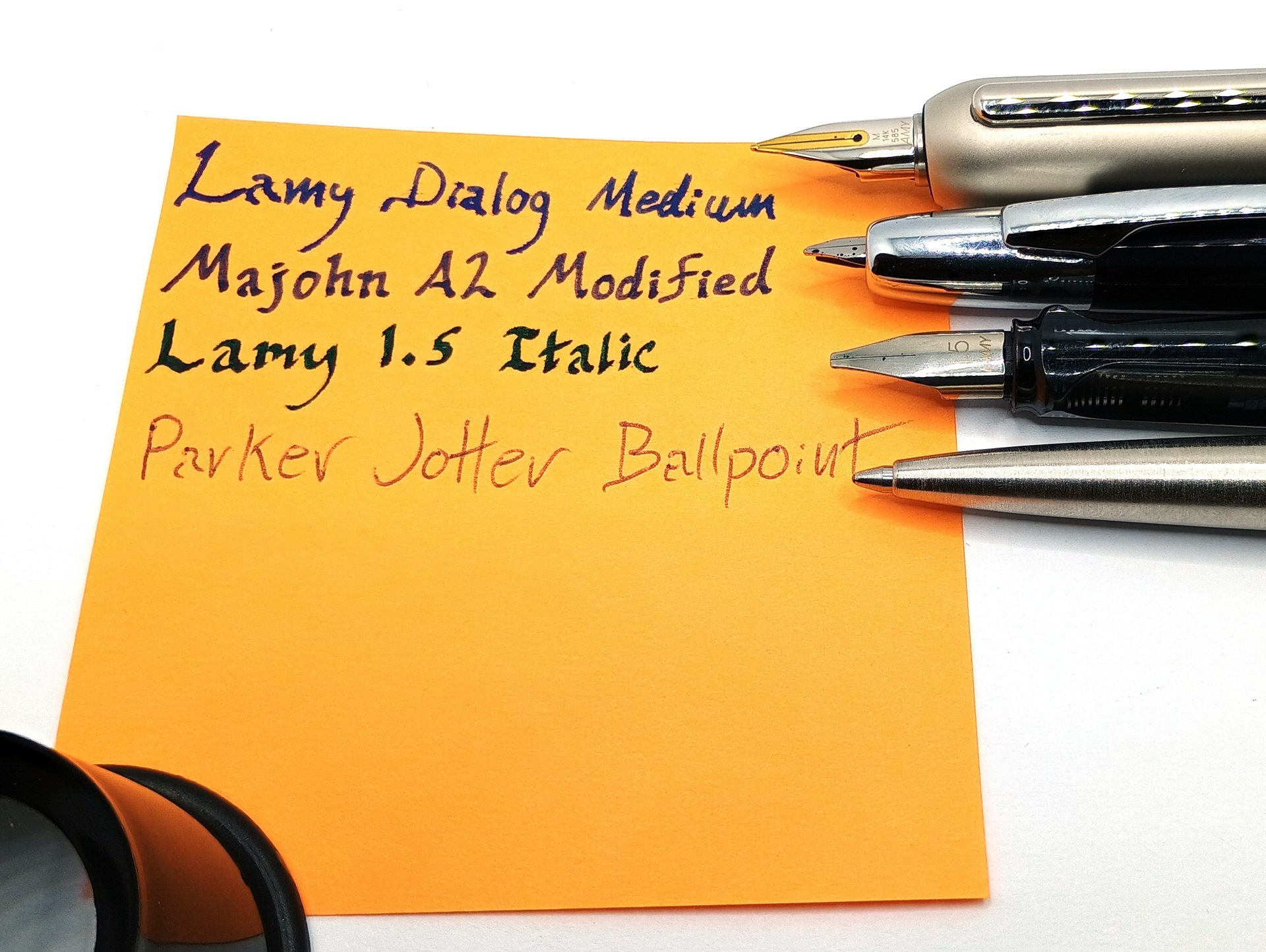
Some of this may be down to the ink, since both of my Lamy pens are currently loaded with genuine Lamy branded ink which seems pretty thin, and they both do this. The Majohn in the middle is filled with Diamine Shimmering Seas which, although weird, seems to be slightly better behaved on bad paper.
This thing would certainly drive any writers of tiny katakana completely nuts. Which is exactly how I like it. Lamy’s blue is also a very transparent ink which combined with the high output results in a pleasing display of shading variation, if you’re into that kind of thing. If you like novelty metallized, shimmering, glittery, or iridescent inks that require you to flood the paper with them in order to do their thing, I think they should all work exceptionally in the Dialog. At least if you select one of the broader nib options.
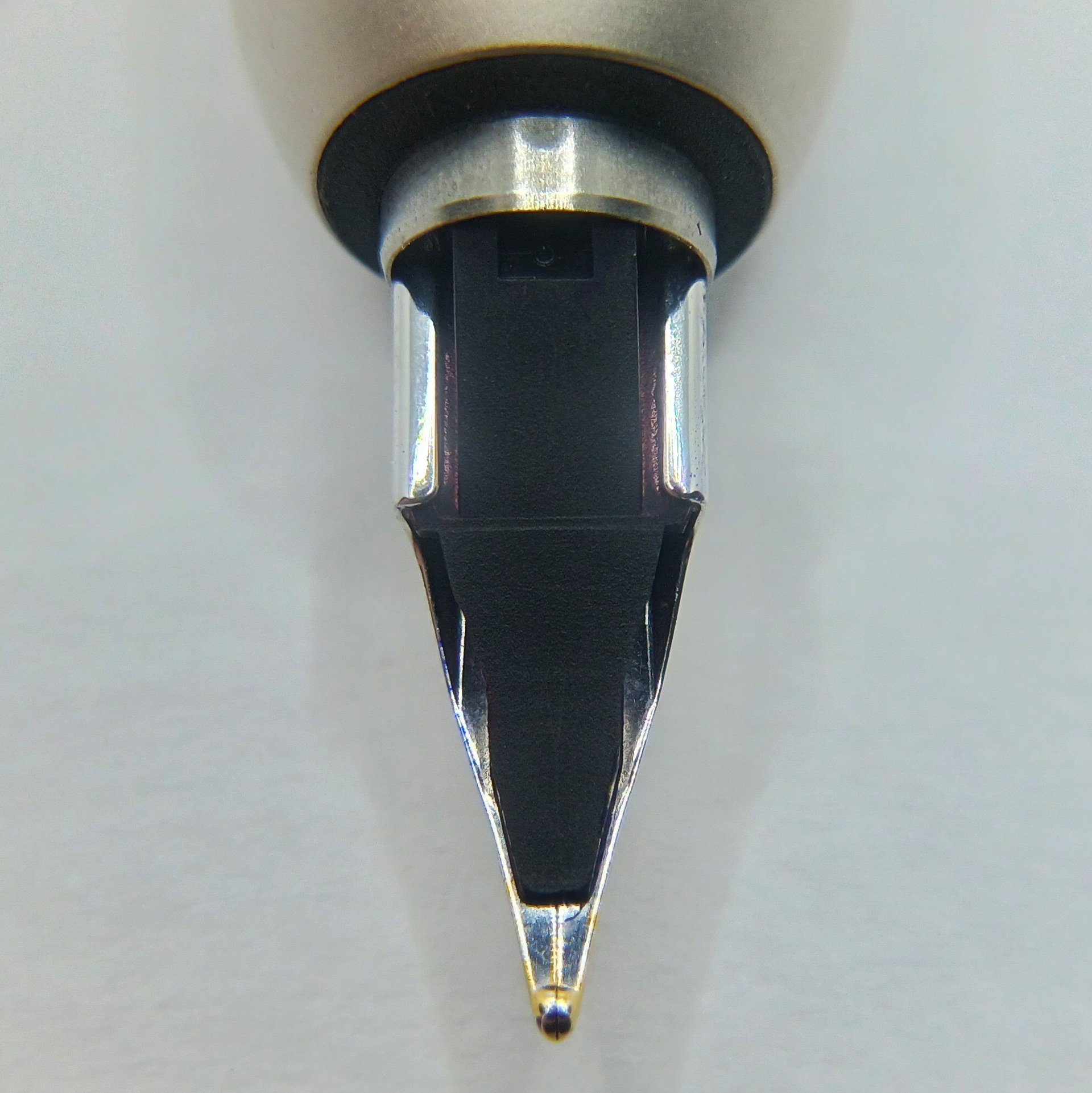
Towards that end, though, all of Lamy’s nibs are interchangeable (except on their 2000 pen) so you could in theory yank the stock nib off of this and replace it with anything. The nib mounting interface is obviously exactly the same as Lamy’s other pens, as shown here. The Z 55 series nibs retail separately for an eye-watering $155, so if gold isn’t your jam you could probably flog yours on eBay and buy a lifetime supply of steel Lamy nibs of all shapes and sizes.
You’re on your own for figuring out how to get the stock nib off without damaging it, though. Lamy describes the standard procedure as to clamp the nib upside down against a table using the bottom of your pen’s cap and yank it off thusly, but the Dialog hasn’t got a cap and the notion of applying unknown tools to a $155 nib isn’t one I find immediately appealing. Especially one that isn’t made of indestructible stainless steel.
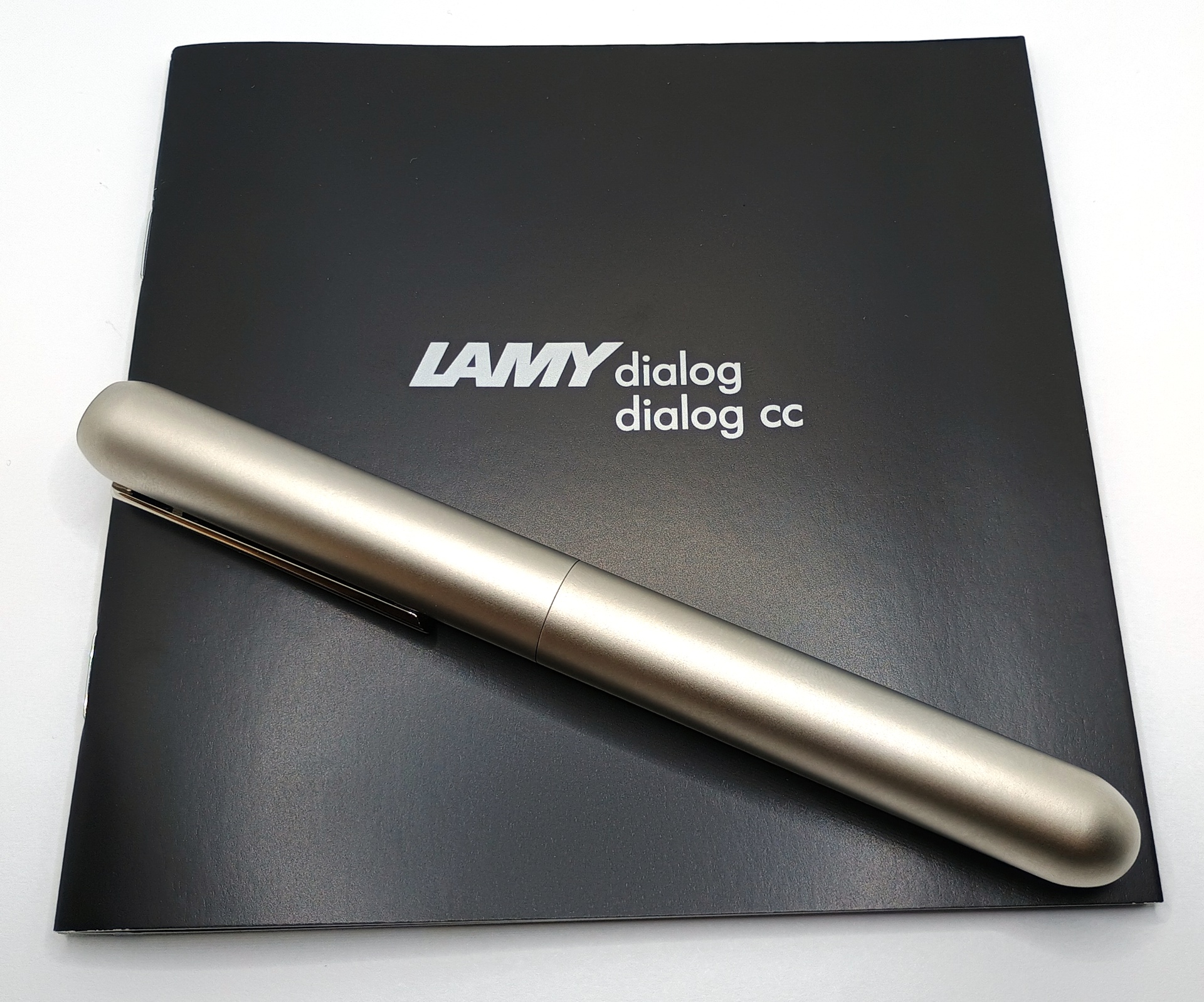
And for its part, the included 39 page double-sided full color glossy instructions manual doesn’t describe how they intend for you to remove the nib from this pen, either, despite going into significant detail about everything else.
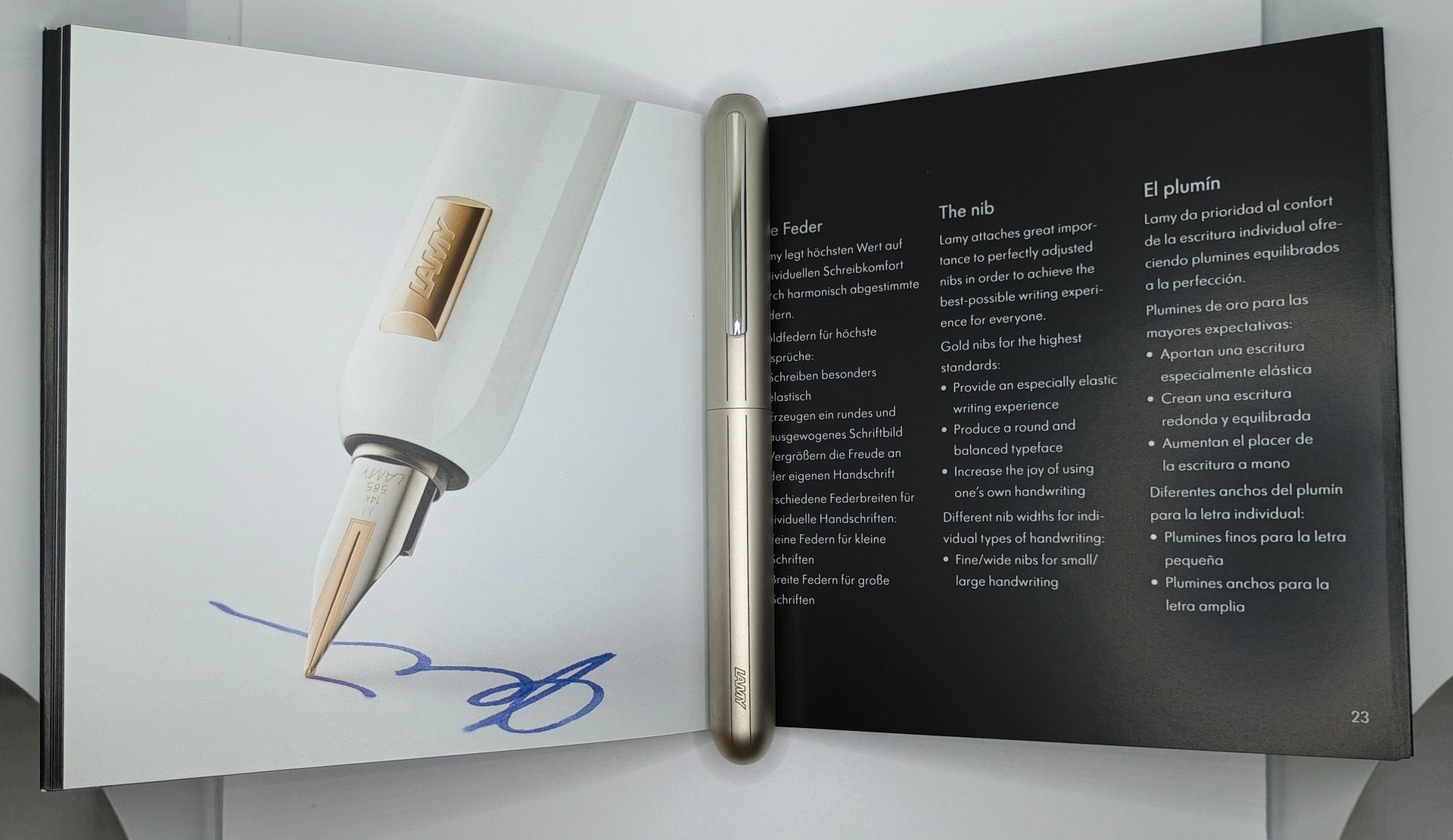
Not even the page specifically about (and titled) the nib.
So I think I’ll leave mine right where it is for now, thanks.
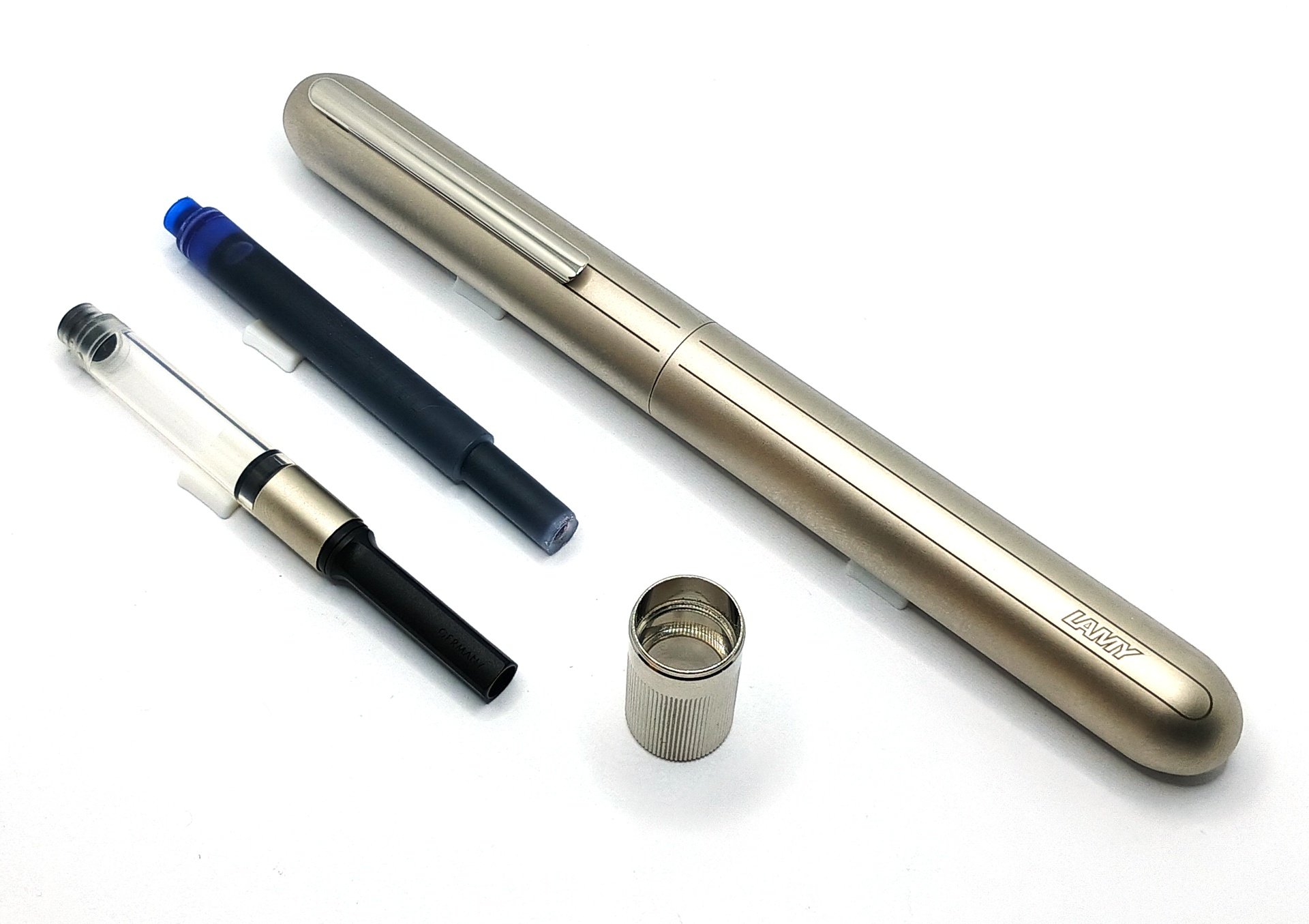
For four hundred bucks you figure they could at least include more than one poxy cartridge. But all you get is a single lonely blue T10 cartridge, an inkwell converter, the pen itself, and one official Lamy Dialog Kurled Thingy.
Lamy apparently do straight-facedly expect you to dip this thing into an inkwell as one of its intended modes of operation, which I think is deeply silly. An entire page is devoted to this in the manual, in fact. Sane people, if using the inkwell converter, will probably want to fill it with a syringe separate from the pen so as not to get ink trapped in every nook and cranny inside that expensive retractable mechanism.
Like most (possibly all?) Lamy pens, the cartridge is not held captive by the tail end of the pen body once assembled and just screwing the halves together won’t pierce a cartridge like on a Sheaffer or Parker. You have to shove it home yourself all the way to get the ink flowing. It’s not even close to being restrained even with the pen assembled and the point fully retracted, with at least half an inch of empty air behind the tail of the cartridge. So it is theoretically possible for it to get knocked off the feed in transit somehow, although I have to imagine any force capable of doing that to a fresh cartridge would probably cause other problems for the pen… or you. But if you’re a habitual cartridge-refiller, be mindful of the necks of your cartridges eventually getting wallered out and loose over time. The neck of the inkwell converter has a rubber gasket on it but the plastic cartridges don’t.
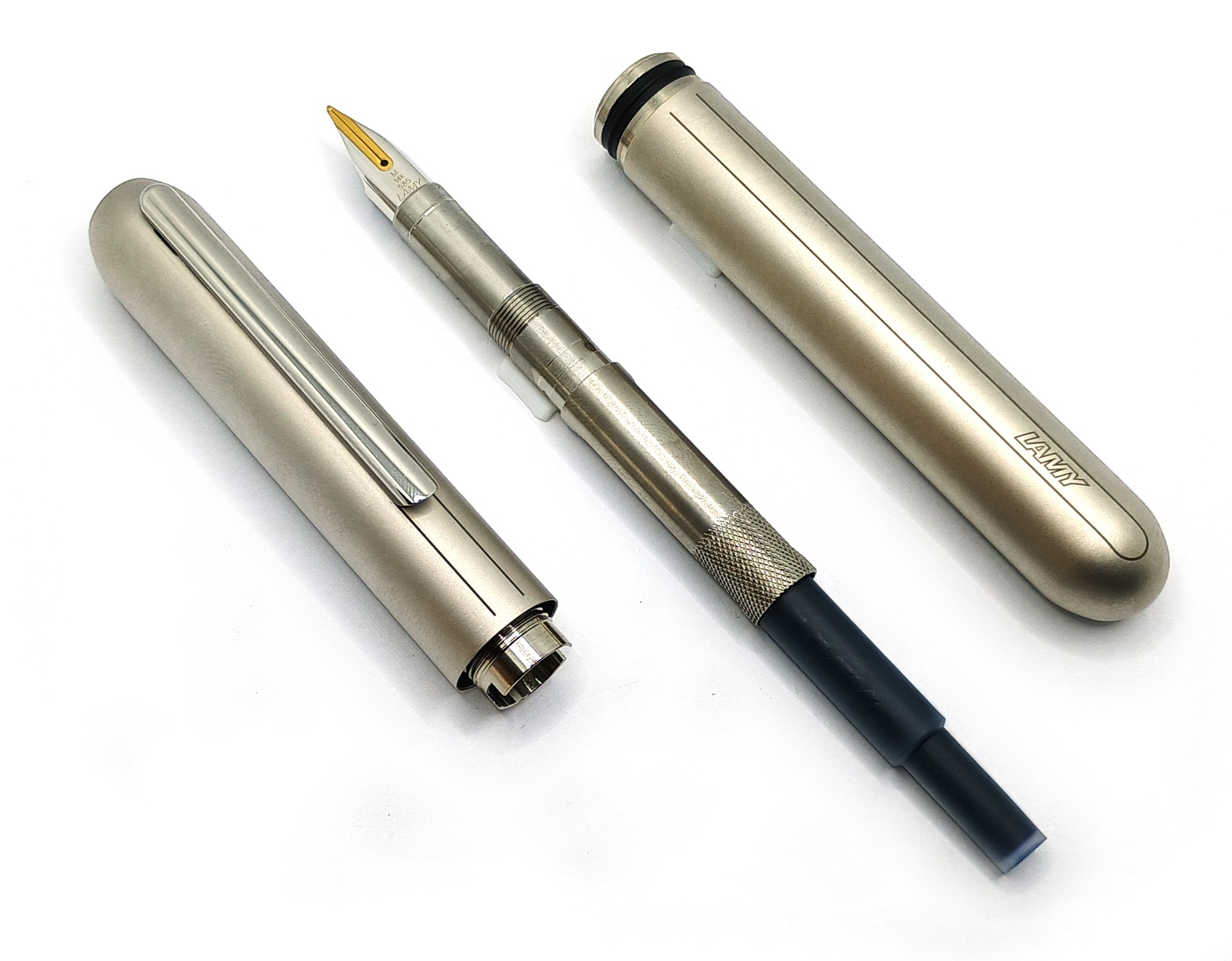
The Dialog comes apart simply by unscrewing it beyond its tip-retracted position.

Inside Lamy is surely showing off with the core feed and nib carrier precision machined with fine crosshatched grip knurling, not to mention various threaded parts. This unscrews from the front section rather than pulling straight out, and is captive until you do so. Unlike other retractables, the Dialog doesn’t appear to contain any springs.

The Knurled Thingy is actually a cleaning tool.
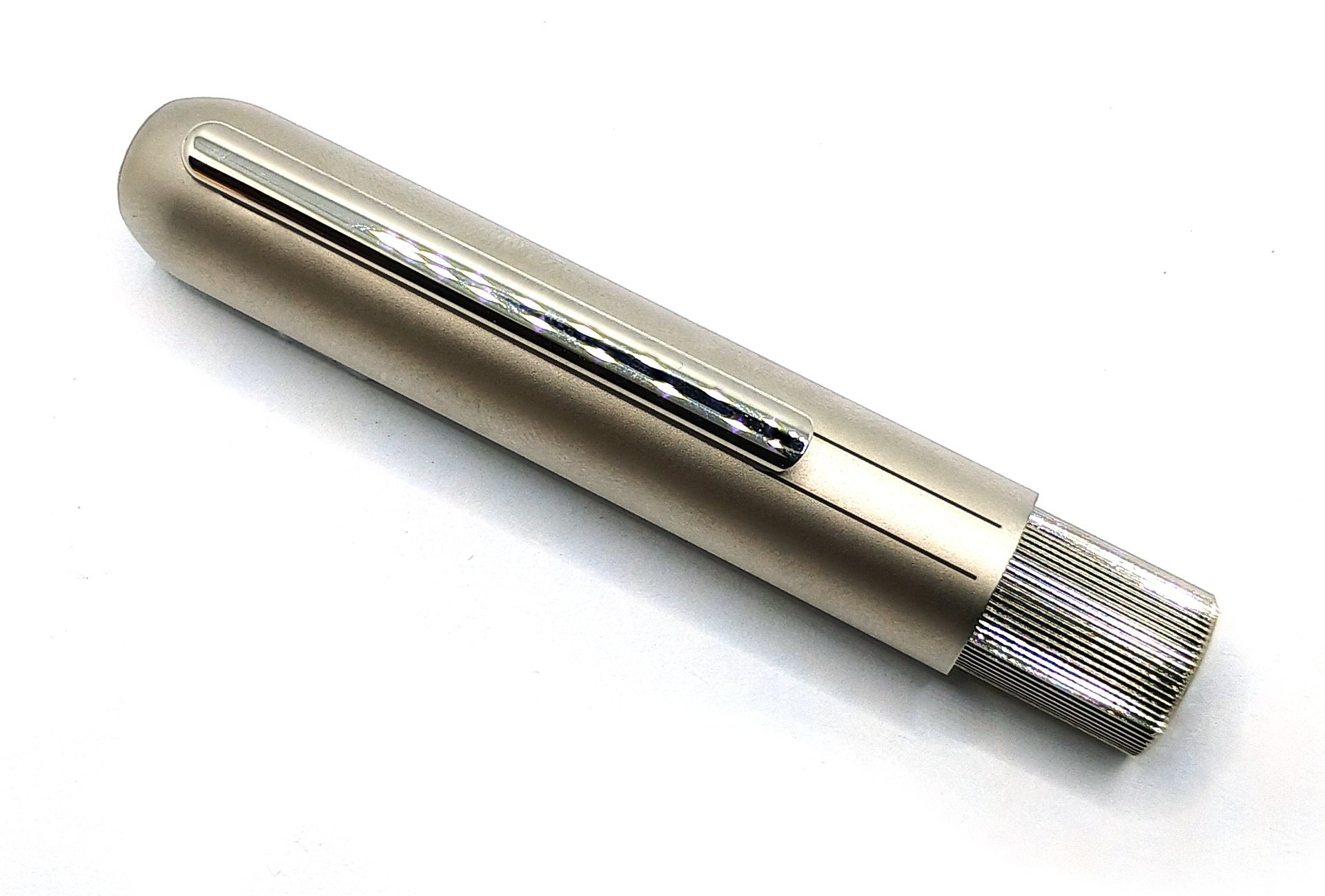
It can be screwed on in place of the core, and if you twist it further it’ll open the ball valve mechanism at the front of the pen, the same as if you’d deployed the point normally.
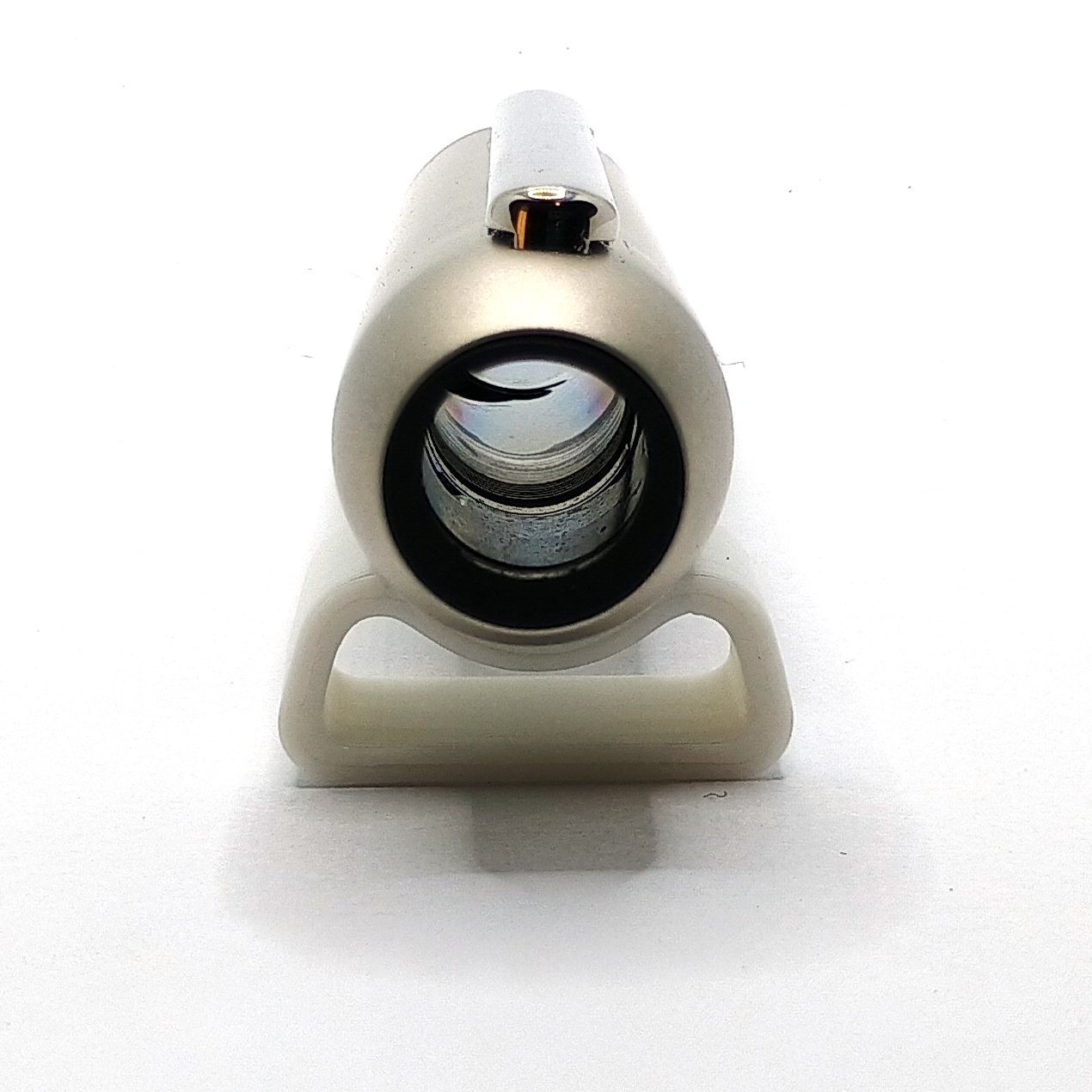
This enables you not only to peer straight through the thing and out the other side, but also gets the valve out of the way so you can rinse the section out or get a Q-tip through it.

As far as feel in the hand goes, the Dialog is, of course, absolutely boss. Flawless provided only that you can handle its girth. I was surprised to find that mine did require a noticeable amount of break in before it would write reliably, however. Maybe this is normal for Lamy’s gold nibs, but it’s the first and only one of those I’ve ever owned (despite having handled oodles of their steel ones in my time) so maybe that’s normal.
Out of the box it was reliably unreliable, invariantly failing to write for the first quarter inch or so any time it’d been left idle without putting down any ink for more than a few seconds. Once it got going it was bulletproof. This behavior stopped after about two days of use.
I’ve seen this sort of thing before and it’s either cured by a few lashes on a fine Arkansas stone or a thorough cleaning, both of which I was avoiding at first to see if the Dialog would improve on its own, because at the price it retails for it’s the principle of the thing, damn it.
And it eventually did. So that’s nice.
Like most modern pens, the Dialog (and by extension one must assume all Lamy Z 55 nibs) seems to be designed for “smoothness” first and foremost, that being the quality that most fountain pen writers constantly rave about. So its nib is indeed extremely smooth and quite polished. It has no noticeable scratchiness at all, even on cheap paper. It produces a very low resistance writing experience, which is fine if that’s your preference but if your writing style relies on friction against the paper to maintain control then the Dialog may annoy you because it has very, very little of that.
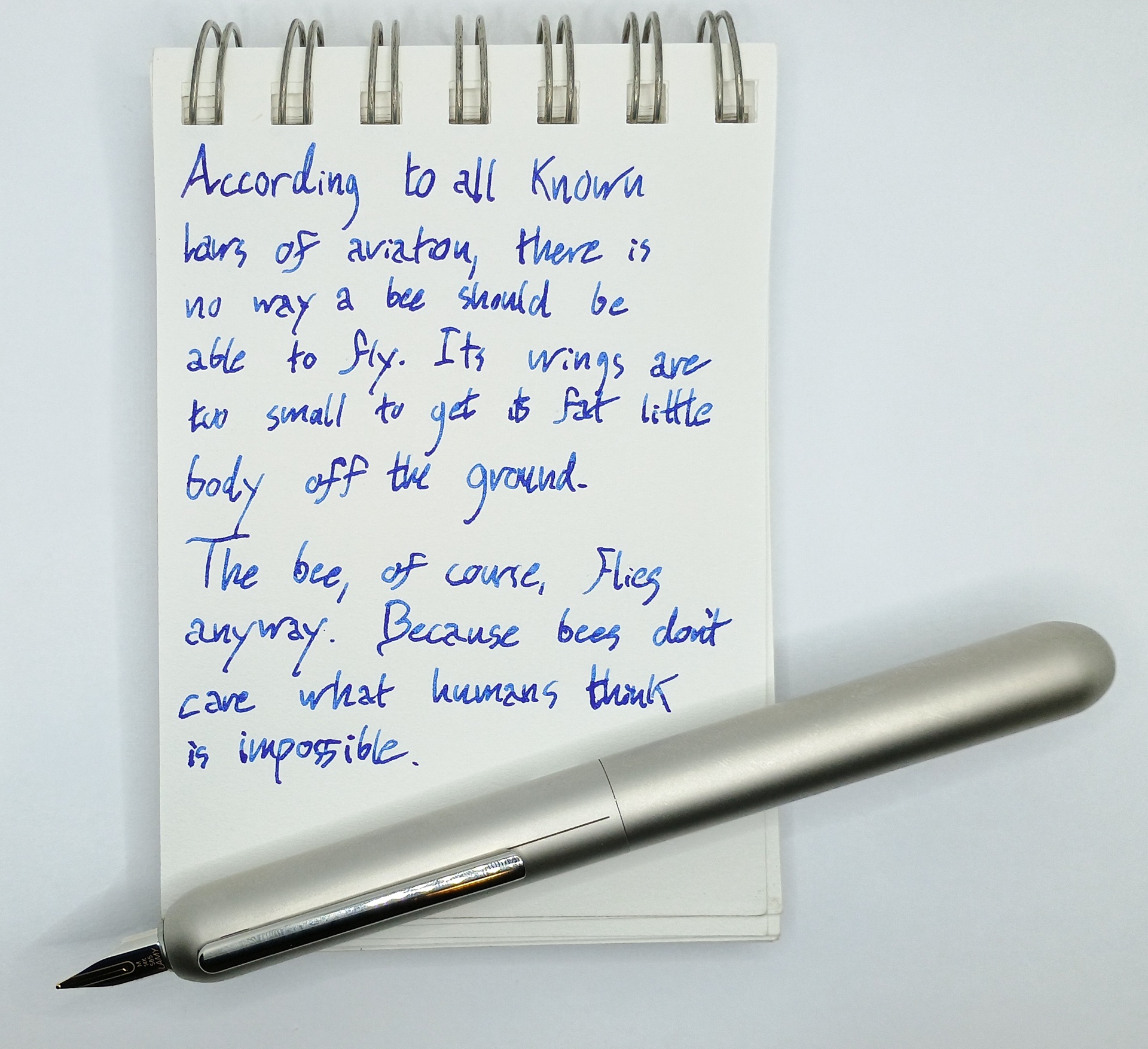
Also, despite its massive heft it actually will not reliably write with no pressure on the paper other than its own weight. Very little pressure is required to get the ink to flow, for sure, but some is always required. More pressure results in a wider stroke, and depending on your habitual baseline level of pressure against the paper you may find you wind up with little to no variation at all which is certainly the case for me. If you conscientiously try to begin all of your strokes with the absolute minimum of pressure to get the Dialog to write reliably you can achieve about a 2:1 variation in stroke width. With my medium nib and by my measure, the Dialog will produce a 0.52mm line at minimum and 1.04mm at maximum. I don’t know how that ranks on the scale of “expressiveness,” but I have $2 Speedball dip pen nibs that are capable of more variation and are more controllable to boot. Make of that what you will.
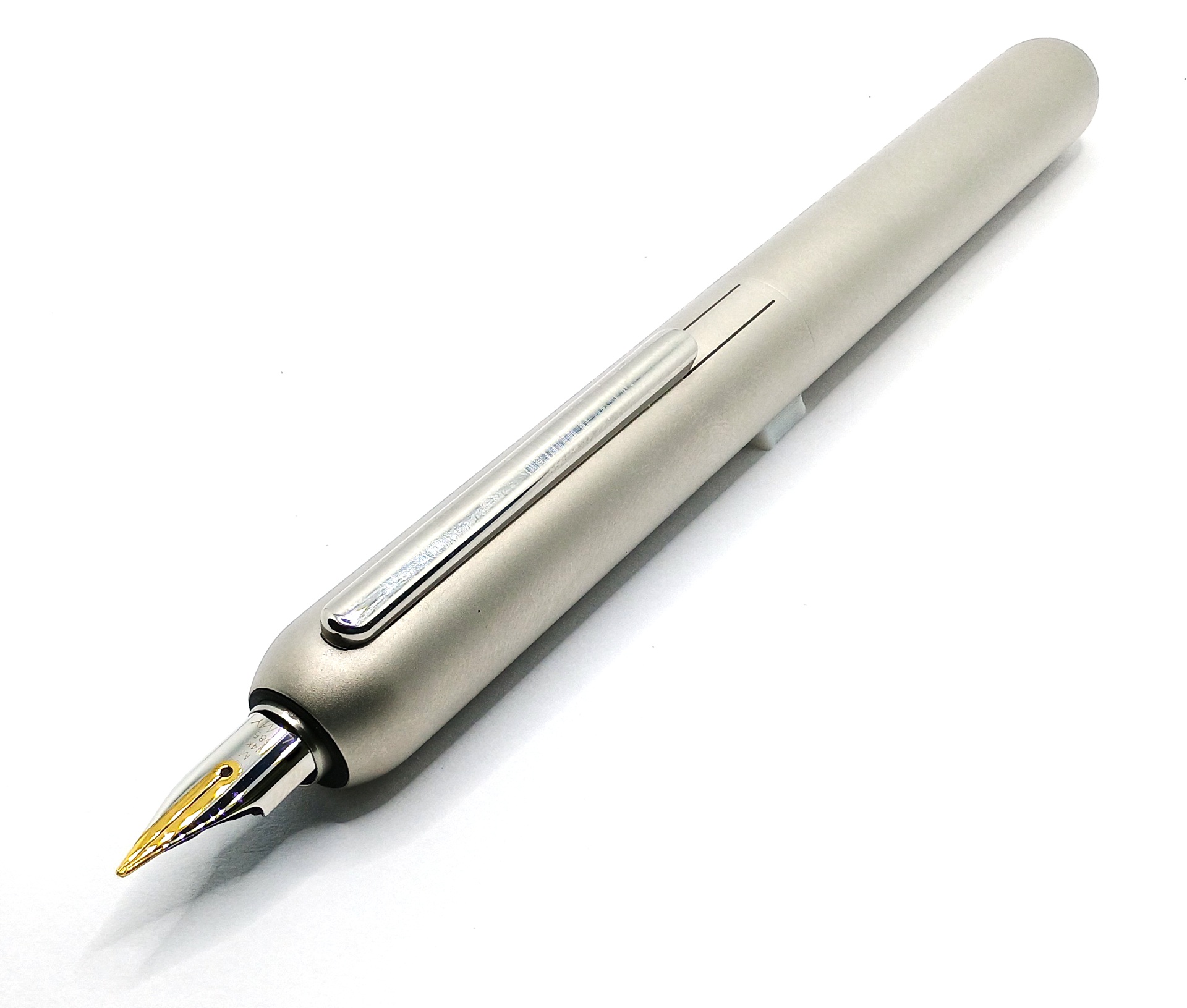
Everyday practicality is where retractable fountain pens aim to shine, of course. That’s why I like all mine, anyway, but on the topic of the Dialog I’m of two minds about that. It is, undoubtedly, a very fine pen. Exquisitely constructed, luxurious, and without a doubt a very special object to behold. I can’t say a single thing against it, there.
It’s just that the twist mechanism is kind of a pain in the ass.
Don’t get me wrong, mechanically it’s certainly very competently built. It’s just not exactly practical. It’s essentially impossible to deploy the Dialog with one hand, which is something that allows its myriad plunger-clicker competitors to walk all over it. Getting out the Dialog certainly feels like an event, a sense that’s no doubt also contributed to by its price. But for quick note taking, intermittent on-again, off-again use, or any spur of the moment anything, it’s just much easier and more convenient to use a clicker pen instead.
There’s also the issue of its completely round cross section. Sure, the sleek Bauhaus minimalism makes it look very swank. But it also makes the bugger very prone to rolling away on you. On a flat surface this is no problem, because any casual accidental bump or nudge will be stopped fairly shortly by the clip. But if you ever use an angled work surface like, oh, a drawing or drafting table, the clip doesn’t protrude enough to stop the pen’s own weight and inertia. The rounded edges on the clip also don’t help. It doesn’t take too steep of a slope at all to enable the Dialog to roll right over its own clip and onto the floor.
Said floor had better then be carpeted, because otherwise you are sure to utter a word that starts with F and ends with K, and it sure won’t be “fire truck.” Especially if the point is deployed at the time.
The Inevitable Conclusion
The Lamy Dialog is a very, very nice pen.
It is certain that the majority of its owners, however, will only be two types of people. Type the first will be those who buy it as a bauble or a status symbol, a prestige piece, probably to use it rarely if ever. Type the second will be dyed-in-the-wool enthusiasts, who will buy and use it despite knowing all of its shortcomings because of what it is, and that’s the type of people they are.
Either camp will have to be willing to part with the better part of a week’s paycheck or more to afford one. For a pen that ultimately doesn’t do much to functionally outshine its competition, that’s a pretty high bar to clear.
But none of that prevents the Dialog from being an item that is even at a glance from a casual observer, uniquely and unquestionably special.
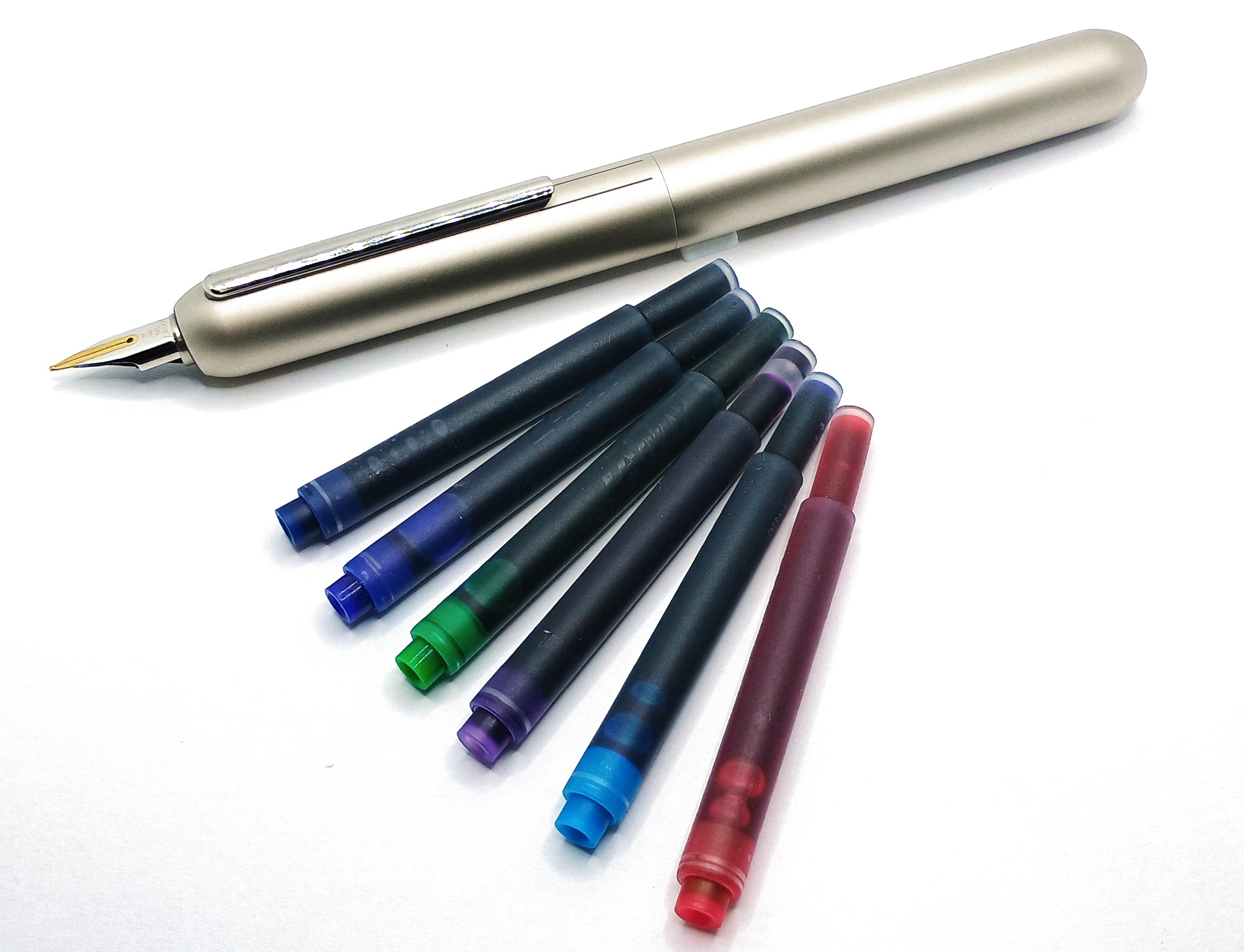


What a great review. Thanks. I was considering buying one, but I’m not sure anymore. As a retractable fp, it looks great. But the cost…